
The skipjack is a traditional fishing boat used on the Chesapeake Bay for oyster dredging. It is a sailboat which succeeded the bugeye as the chief oystering boat on the bay, and it remains in service due to laws restricting the use of powerboats in the Maryland state oyster fishery.

The log canoe is a type of sailboat developed in the Chesapeake Bay region. Based on the dugout, it was the principal traditional fishing boat of the bay until superseded by the bugeye and the skipjack. However, it is most famous as a racing sailboat, and races continue to be held.
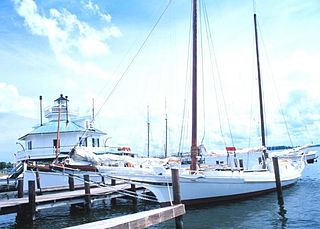
The bugeye is a type of sailboat developed in the Chesapeake Bay for oyster dredging. The predecessor of the skipjack, it was superseded by the latter as oyster harvests dropped.

The Chesapeake Bay Maritime Museum is located in St. Michaels, Maryland, United States and is home to a collection of Chesapeake Bay artifacts, exhibitions, and vessels. This 18-acre (73,000 m2) interactive museum was founded in 1965 on Navy Point, once a site of seafood packing houses, docks, and work boats. Today, the Museum houses the world's largest collection of Chesapeake Bay boats and provides interactive exhibits in and around the 35 buildings which dot the campus. The Museum also offers year-round educational seminars and workshops.

The Edna E. Lockwood is a Chesapeake Bay bugeye, the last working oyster boat of her kind. She is located at the Chesapeake Bay Maritime Museum in Saint Michaels, Maryland. She was built in 1889 at Tilghman Island, Maryland by John B. Harrison and is of nine-log construction, similar to the smaller log canoe, and was launched on October 5, 1889 for Daniel Haddaway, at a cost of $2,200. She worked for at least seven sets of owners from 1899 until 1967, and was then sailed as a yacht until donated to the museum in 1973. The museum undertook an extensive restoration of the Lockwood from 1975 through 1979, which restored the bugeye to its 1910 appearance with the "patent stern" that had been added sometime prior to that year. She is the last bugeye retaining the sailing rig and working appearance of the type. Her length is 53.5 feet (16.3 m), with a 15.25 feet (4.65 m) beam and a draft of 2.58 feet (0.79 m) with the centerboard up, and a maximum sail area of approximately 1700 square feet.

The Rebecca T. Ruark is a Chesapeake Bay skipjack built at Taylor's Island, Maryland. She is homeported at Tilghman Island, Maryland. Built in 1896, she is the oldest surviving skipjack in the Chesapeake Bay fleet. She was designated a National Historic Landmark in 2003.

E.C. Collier is a Chesapeake Bay skipjack, built in 1910 at Deal Island, Maryland. She is a 52-foot-long (16 m) two-sail bateau, or "V"-bottomed deadrise type of centerboard sloop. She has a beam of 17.9 feet (5.5 m), a depth of 4.5 feet (1.4 m), and a registered net tonnage of 14 tons. She is one of the 35 surviving traditional Chesapeake Bay skipjacks and a member of the last commercial sailing fleet in the United States. At the time of her documentation on the National Register of Historic Places she was located at Tilghman, Talbot County, Maryland. She is now a permanent exhibit at the Chesapeake Bay Maritime Museum in Saint Michaels, Maryland.

The Maggie Lee is a Chesapeake Bay skipjack, built in 1903 at Pocomoke City, Maryland. She is a 51' long two-sail bateau, or "V"-bottomed deadrise type of centerboard sloop. She has a beam of 16', a depth of 3.8', and a net tonnage of 8 register tons. She is one of the 35 surviving traditional Chesapeake Bay skipjacks and a member of the last commercial sailing fleet in the United States. She is located at Denton, Caroline County, Maryland.

The Minnie V is a Chesapeake Bay skipjack, built in 1906 at Wenona, Maryland. She is a 45.3' long two-sail bateau, or "V"-bottomed deadrise type of centerboard sloop. She has a beam of 15.7' and a depth of 3' with a net registered tonnage of 8 tons. She is one of the 35 surviving traditional Chesapeake Bay skipjacks and a member of the last commercial sailing fleet in the United States. She is located at Tilghman, Talbot County, Maryland.
The Nellie L. Byrd is a Chesapeake Bay skipjack, built in 1911 at Oriole, Maryland. She is a 53.6' long two-sail bateau, or "V"-bottomed deadrise type of centerboard sloop. She has a beam of 26.7', a depth of 4.8', and a net tonnage of 18 tons. She is one of the 35 surviving traditional Chesapeake Bay skipjacks and a member of the last commercial sailing fleet in the United States. When listed, she was located at Tilghman, Talbot County, Maryland. Since 2005, she is located at Middle River, Maryland, Baltimore County, Maryland.
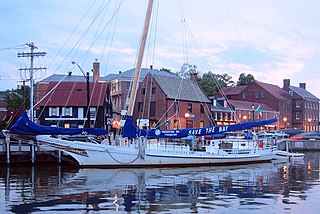
The Stanley Norman is a Chesapeake Bay skipjack, built in 1902 by Otis Lloyd, Salisbury, Maryland. She is a 48-foot-3-inch-long (14.71 m) in Length overall with length on deck (LOD) OF 47.5-foot-long (14.5 m) two-sail bateau, or "V"-bottomed deadrise type of centerboard sloop. She has a beam of 16 feet (4.9 m), a depth of 4 feet (1.2 m) at the stern with the centerboard up, and a registered tonnage of 7 tons.
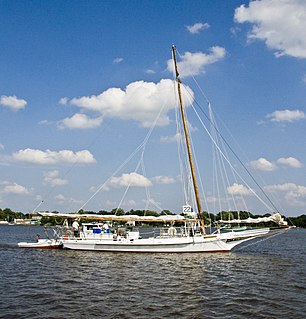
The Elsworth is a Chesapeake Bay skipjack, built in 1901 at Hudson, Maryland. She is a 39.9-foot-long (12.2 m) two-sail bateau, or "V"-bottomed deadrise type of centerboard sloop. She has a beam of 14.3', a depth of 3.1', and a gross registered tonnage of 8 tons. She is one of the 35 surviving traditional Chesapeake Bay skipjacks and a member of the last commercial sailing fleet in the United States.
The Ruby G. Ford was a Chesapeake Bay skipjack, built in 1891 at Fairmount, Maryland. She was a 45-foot-long (14 m) two-sail bateau, or "V"-bottomed deadrise type of centerboard sloop. She had a beam of 15.6 feet (4.8 m), a depth of 2.6 feet (0.79 m), and a net tonnage of 5 register tons. She was one of the 35 surviving traditional Chesapeake Bay skipjacks and a member of the last commercial sailing fleet in the United States.

The Sigsbee is a Chesapeake Bay skipjack, built in 1901 at Deal Island, Maryland, United States. She is a 47-foot-long (14 m) two-sail bateau, or "V"-bottomed deadrise type of centerboard sloop. She has a beam of 15.8 feet (4.8 m), a depth of 3.8 feet (1.2 m), and a gross registered tonnage of 8 tons. She is one of the 35 surviving traditional Chesapeake Bay skipjacks and a member of the last commercial sailing fleet in the United States. She is owned and operated by the Living Classrooms Foundation in Baltimore, Maryland.
The F. C. Lewis Jr. is a Chesapeake Bay skipjack, built in 1907 at Hopkins, Virginia. She is a 39-foot-long (12 m) two-sail bateau, or "V"-bottomed deadrise type of centerboard sloop. She has a beam of 14.6 feet (4.5 m) and a register depth of 3 feet (0.91 m); her register tonnage is 6. She is one of the 35 surviving traditional Chesapeake Bay skipjacks and a member of the last commercial sailing fleet in the United States. She is located at Wenona, Somerset County, Maryland.
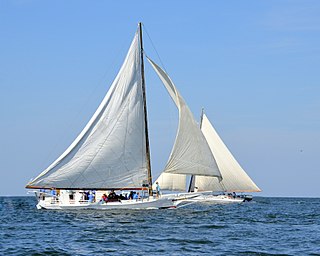
The Fannie L. Daugherty is a Chesapeake Bay skipjack, built in 1904 at Crisfield, Maryland. She is a 41.3-foot-long (12.6 m) two-sail bateau, or "V"-bottomed deadrise type of centerboard sloop. She is built by cross-planked construction methods and has a beam of 8 feet (2.4 m) and a depth of 3.6 feet (1.1 m). She one of the 35 surviving traditional Chesapeake Bay skipjacks and a member of the last commercial sailing fleet in the United States. She is located at Wenona, Somerset County, Maryland.
Martha Lewis is a Chesapeake Bay skipjack built in 1955. Her home port is Havre de Grace, Harford County, Maryland.
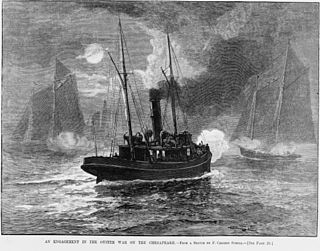
The Oyster Wars were a series of sometimes violent disputes between oyster pirates and authorities and legal watermen from Maryland and Virginia in the waters of the Chesapeake Bay and the Potomac River from 1865 until about 1959.

Rosie Parks is a Chesapeake Bay skipjack built in Wingate, Maryland, in 1955 by Bronza Parks. She is owned by the Chesapeake Bay Maritime Museum (CBMM); her hailing port is Cambridge, Maryland. Rosie Parks was purchased by CBMM in 1975 from Orville Parks—the boatbuilder's brother—and she was the first skipjack to be preserved afloat by a museum. On November 2, 2013, Rosie Parks was relaunched after a three-year restoration. She is assigned Maryland dredge number 19.

An oyster buy-boat, also known as deck boat, is an approximately 40–90 foot long wooden boat with a large open deck which serviced oyster tongers and dredgers. Similar in function to sardine carriers, buy boats circulated among the harvesters collecting their catches, then delivered their loads to a wholesaler or oyster processing house. This spared the fishermen the task and its downtime, allowing them to catch more oysters. Buy-boats also bought seed oysters, or spat, for planting in oyster beds.
















